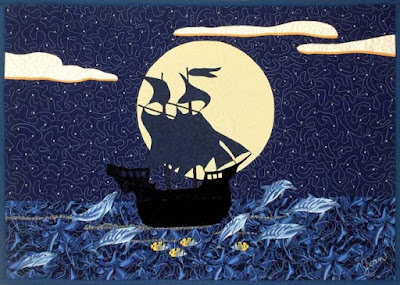 |
| Parrot Bay - an art quilt by Jean Baardsen |
To go to the beginning of this book, Tropic Moon: Memories, click HERE.
We spent
most of the month of July anchored in Road Town, living rather quietly, since
Ed couldn't leave the boat. In the middle of the month a tropical wave
passed through. While a tropical wave is not as bad as a tropical storm,
which isn't as bad as a hurricane, it's still lousy weather, with heavy winds and
driving rain. We had to put out a second anchor during the worst of the
storm. Ed, with his back problems, had
trouble setting it. We were only too well aware that Hurricane Season was
upon us, and that we would have problems securing the boat if a trip to
Hurricane Hole became a necessity.
Ed had
assured me that once the muscle pains in his back eased, it would be the end of
his problems. He’d said the same thing when the pains were in his hip
area, but this time he was right; he finally started moving around the boat
again. We left Road Town on July 25th and stopped for a few days at St.
Francis Bay on St. John. The improvement came rapidly. Ed was once
again pacing the deck for exercise and rowing the dinghy into shore - his first
time off the boat in 35 days! From that point on, he steadily improved,
walked normally again, and could go for miles at a time.
 |
| Parrot Bay - Detail |
Courtesy of our cruising lifestyle, I faced my own “health
challenge” – finding an ongoing supply of birth control pills…. Since St. Thomas belongs to the United
States, I went ashore in Charlotte Amalie one day, hoping to locate a Family Planning clinic. I went to the Legislature building, looking
for a phone book. I wanted a number for
Planned Parenthood, but didn’t find it listed.
A man working there offered to help me.
He introduced himself as the special assistant to the head of the
Senate. He called around, and found the
location for Family Planning. He ended
up driving me there himself! I think he
just wanted to get out of the office for a while.
I made an
appointment, and returned on that day.
When I reached Family Planning, I was told the clinic was being held in
Frenchtown, which was across town from where I was. I drove over with three black women. It turned out they were the nurse (driving), the doctor, and the
receptionist. I carried the black
bag! We opened the clinic, where there
were a few other women waiting. The
doctor proceeded to throw a fit. The
water was off – again! She was yelling
about how unsanitary it was for her to examine women without being able to wash
her hands in between. No kidding! There was a water cooler at the clinic. The doctor would take a cup of water to use
with each patient. I was glad I was the
second patient. I had the exam, and got
six months of birth control pills. Even
that took some talking. Three months of
pills was the limit they were allowed to hand out at one time.
 |
| Parrot Bay - Detail |
July
28th was Hurricane Supplication Day in the U.S. Virgin Islands.
It's when everyone gets the day off from work to supplicate the gods for
safekeeping from the hurricanes. One week later Hurricane Allan (the
worst of the century, topping the previous year's Hurricane David)
blew into the Caribbean. Someone in the Virgin Islands must have prayed
effectively, because Hurricane Allan stayed well to the south of the Virgins,
merely causing bad squalls in our area. To be on the safe side, we
motored over to Hurricane Hole on St. John.
We secured Tropic Moon with three anchors, and three lines to
shore. While there, taking advantage of the calm waters, we worked from
the dinghy and painted the second half of the topsides. Compared with the previous year,
very few boats bothered to take the trouble to leave their regular anchorages.
While in
Hurricane Hole, we ran into some people we’d met briefly in Antigua in
February. Jerry and Martin were living
on a sailboat, Travel. In May they’d
decided to sail to the Chesapeake Bay, by way of Bermuda. Bermuda is 950 miles due north of the Virgin
Islands. They liked Bermuda and stayed
for five weeks. While there, they
learned that Martin could have a job on Tortola as a mechanic with a bare-boat
charter company – so they sailed straight back to the Virgins. I was somewhat aghast at the thought of
sailing 1900 miles of open water, and ending up right back where you’d
started. Martin and Jerry were from
England. They’d crossed the Atlantic three
times, so it wasn’t anything to them.
They told us they were staying semi-permanently at Maya Cove, on
Tortola. We said we’d look them up.
Waiting
out Hurricane Season, we spent August through October cruising the U.S. and
British Virgin Islands. It was a
relaxing time, and a nice change not having to face any new islands, with the
attendant problems of locating food, water, and marine supplies. Our sailing was measured in terms of a few
hours, rather than a few days. After
spending our second summer in the Virgins, we knew the islands well enough that
we seldom took out a chart.


























